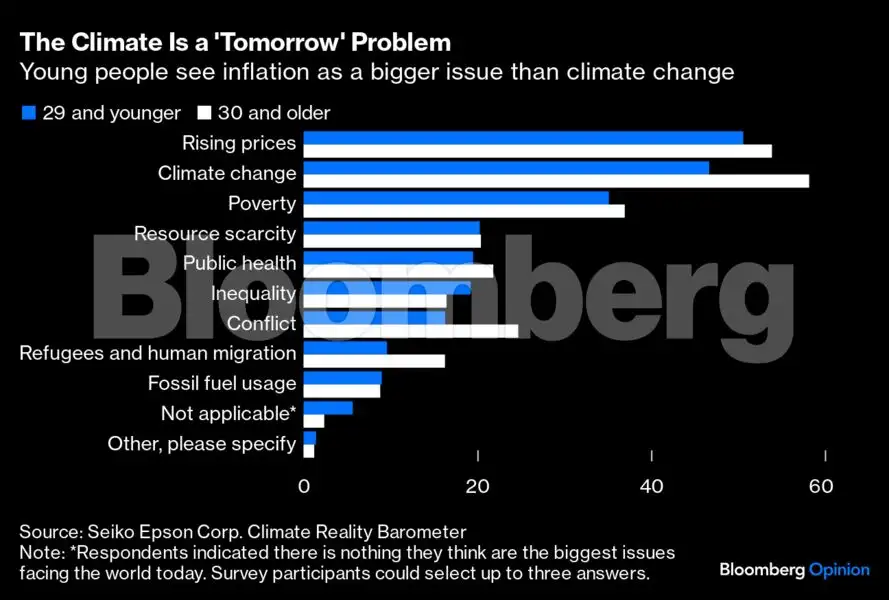The sense of failing to convey to your stovetop mates that you are all boiling alive was hammered home this week by a new survey showing young people — humanity’s hope for the future, supposedly — care more about inflation than they do about climate change. This in the middle of what will probably be the hottest year in human history, wracked with deadly floods, droughts, heat waves and wildfires.
On the one hand, this suggests “climate Cassandra” is a poor career choice. On the other, it makes total sense. Though my memories of young adulthood are hazy, one lingering sensation is relentless financial dread. And today’s youths have it far worse than I ever did. College, health-care and housing expenses have soared in recent decades, followed by food and other prices since the Covid pandemic. It’s tough to focus on the future of the climate when your stomach is grumbling and you’re not sure you can cover the rent.

But the reality is that climate change and inflation are increasingly, inextricably linked. A hotter planet makes droughts, floods, heat waves and destructive storms more likely and more intense. Rainfall patterns change and diseases roam more widely. All of this in turn disrupts agriculture, construction, shipping, manufacturing and more. Natural disasters and rising sea levels will leave some parts of the country inhabitable only by the very wealthy, making affordable housing even more scarce. The pandemic’s inflationary supply-chain nightmares were just a preview of what may be in store.
 Bloomberg
BloombergOne heat wave alone boosted European food prices by 0.67% in 2022, according to a recent study by the European Central Bank and the Potsdam Institute for Climate Impact Research. Future warming could raise global food inflation by 0.9% to 3.3% a year by 2035, the study suggested, depending partly on how hot we let the planet get by then. Total inflation could be 0.3% to 1.2% higher a year (food inflation is typically more volatile than “headline” inflation; hence the bigger potential swings).Global corn production could fall 6% by the end of the century under even the most optimistic carbon-emission forecasts, according to a 2021 study by NASA and a host of other researchers. And most of that effect would happen before 2040. By that time, every county in Iowa will experience at least a 45% increase in the number of days under corn-killing temperatures, according to an Environmental Defense Fund study.
This summer in the US alone, everyone from Nebraska cattle ranchers to Long Island kelp harvesters suffered lower yields as land and sea broiled under record temperatures. A June study in the journal Nature warned that wheat growers in the US and China aren’t prepared for just how much more destructive future heat waves will be.
Meanwhile, storms, water shortages and power failures will disrupt manufacturing. Heat will threaten the health of farm, construction and other outdoor workers and trigger demands for higher pay and better conditions. Shrinking rivers will slow container shipping. Millions of US homes are at risk of catastrophic flooding and their owners don’t even know it. All of this spells supply headaches and higher prices.
Technology can help us adapt to a hotter future, at least somewhat. Farmers can use land and water more efficiently and breed heat-resistant crop strains. Businesses can weatherproof their infrastructure and diversify their supply chains. But all of that will be pricey, at least in the short term, adding still more inflationary pressure. Developing nations will struggle to keep up without (expensive) assistance from the developed world.
Fending off the worst of climate change, and the inflation and disruption it brings, won’t be cheap either, of course. Limiting global warming to 1.5C above pre-industrial averages could cost nearly $200 trillion in green investments by 2050, Bloomberg NEF has estimated. That also sounds pretty inflationary. But in the meantime it will generate economic growth, spur new technologies and industries and prevent even greater amounts of future death, destruction and — for some of us worst of all — inflation.










